It’s always a delight to see hummingbirds visiting our gardens. Their iridescent feathers and aerial acrobatics can liven up our outdoor spaces and give us something to look forward to when they return to our backyards after the cold winter. Beyond that, hummingbirds are some of the best pollinators around, and they can boost our garden harvests and help us grow healthier plants too!
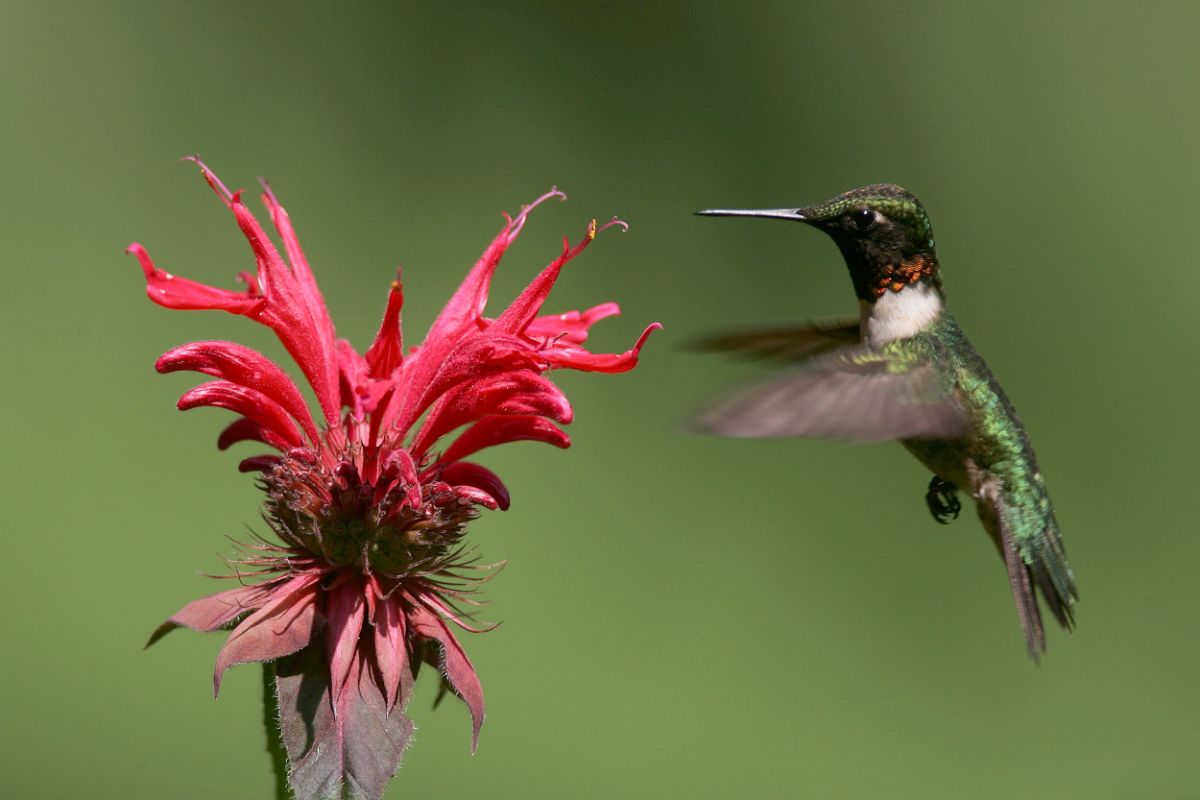
If you love hummingbirds, hanging up a hummingbird feeder can lure these charming, pint-sized birds to your yard. But if you really want to attract hummingbirds, knowing which plants to sow can help. In this guide, we’ll introduce you to the absolute best flowers for hummingbirds that will have your garden abuzz with hummingbirds this season.
Jump to:
- 22 best flowers to grow for hummingbirds
- 1. Butterfly bush (Buddleia davidii)
- 2. Bee balm (Monarda spp.)
- 3. Cardinal flower (Lobelia cardinalis)
- 4. Beardtongue (Penstemon spp.)
- 5. Catmint (Nepeta x faassenii)
- 6. Verbena (Verbena spp.)
- 7. Daylily (Hemerocallis spp.)
- 8. Petunia (Petunia spp.)
- 9. Tall phlox (Phlox paniculata)
- 10. Trumpet vine (Campsis radicans)
- 11. Foxglove (Digitalis spp.)
- 12. Flowering tobacco (Nicotiana spp.)
- 13. Pineapple sage (Salvia elegans)
- 14. Delphinium (Delphinium spp.)
- 15. Eastern red columbine (Aquilegia canadensis)
- 16. Zinnia (Zinnia elegans)
- 17. Bleeding heart (Lamprocapnos spectabilis)
- 18. Hosta (Hosta spp.)
- 19. Salvia (Salvia spp.)
- 20. Red hot poker (Kniphofia uvaria)
- 21. Anise hyssop (Agastache foeniculum)
- 22. Trumpet honeysuckle (Lonicera sempervirens)
- Summary
22 best flowers to grow for hummingbirds
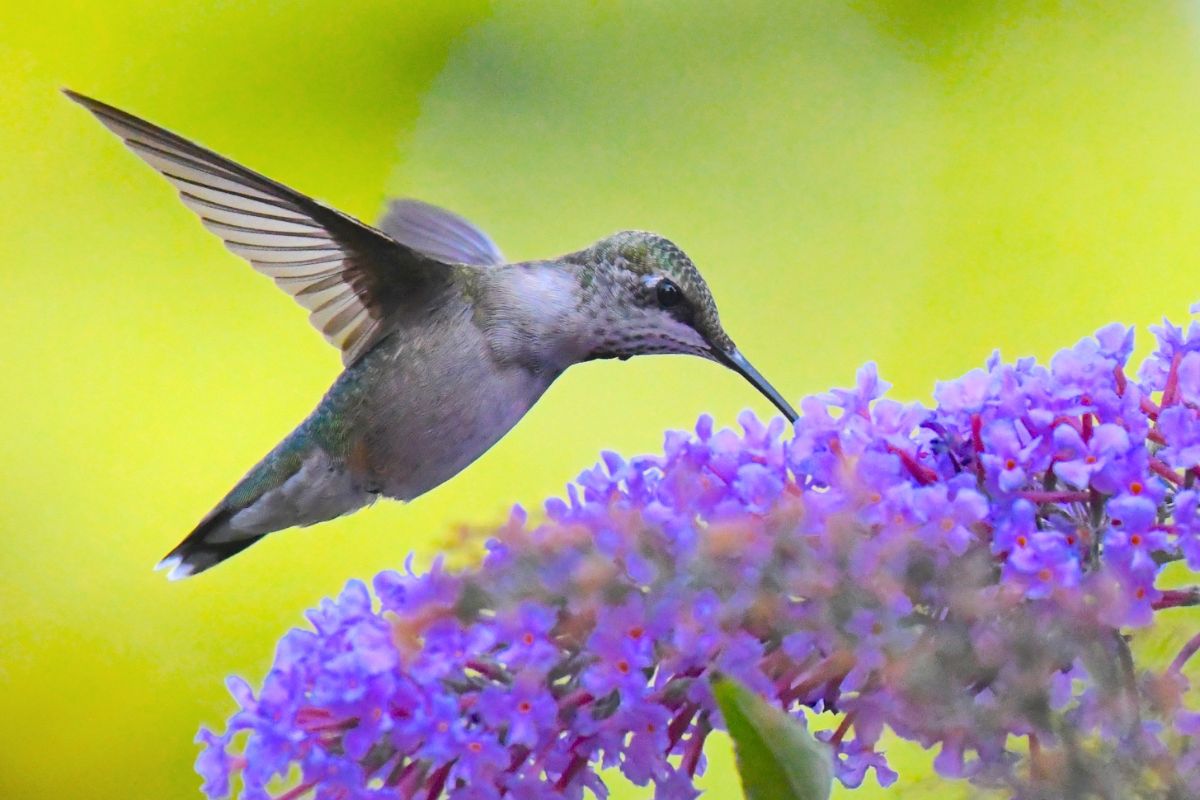
There are a variety of annuals, perennials, and even herbs that hummingbirds can’t resist. Sowing a number of these plants in your garden is an easy way to create a backyard hummingbird habitat and increase the diversity of wildlife in your garden.
1. Butterfly bush (Buddleia davidii)
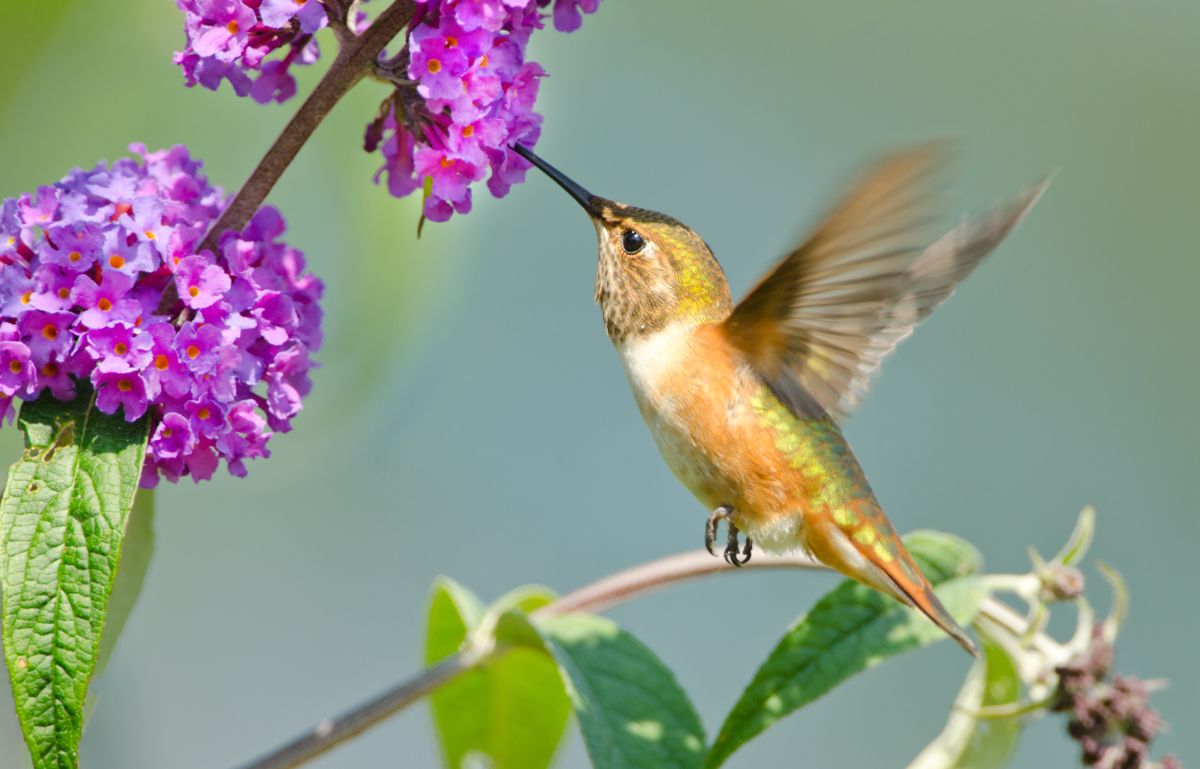
| Plant name: | Butterfly bush |
| Light requirements: | Full sun to partial shade |
| Water requirements: | Moderate |
| Perennial or annual? | Perennial |
| Growing zone: | Zones 5 to 9 |
Despite their name, butterfly bushes aren’t just for butterflies – hummingbirds love them too! In fact, in my garden, I only see a hummingbird or two until the butterfly bushes begin to bloom. Once these fragrant flowers appear, however, my garden is suddenly swarming with lots of hummingbirds who can’t resist the sweet nectar from these plants!
Butterfly bushes grow between 5 and 10’ tall and make excellent backdrops to ornamental beds or standalone specimen shrubs. Flowers come in different colors, including purple, pink, and white. Sometimes called “summer lilacs,” butterfly bushes bloom from summer to fall.
2. Bee balm (Monarda spp.)
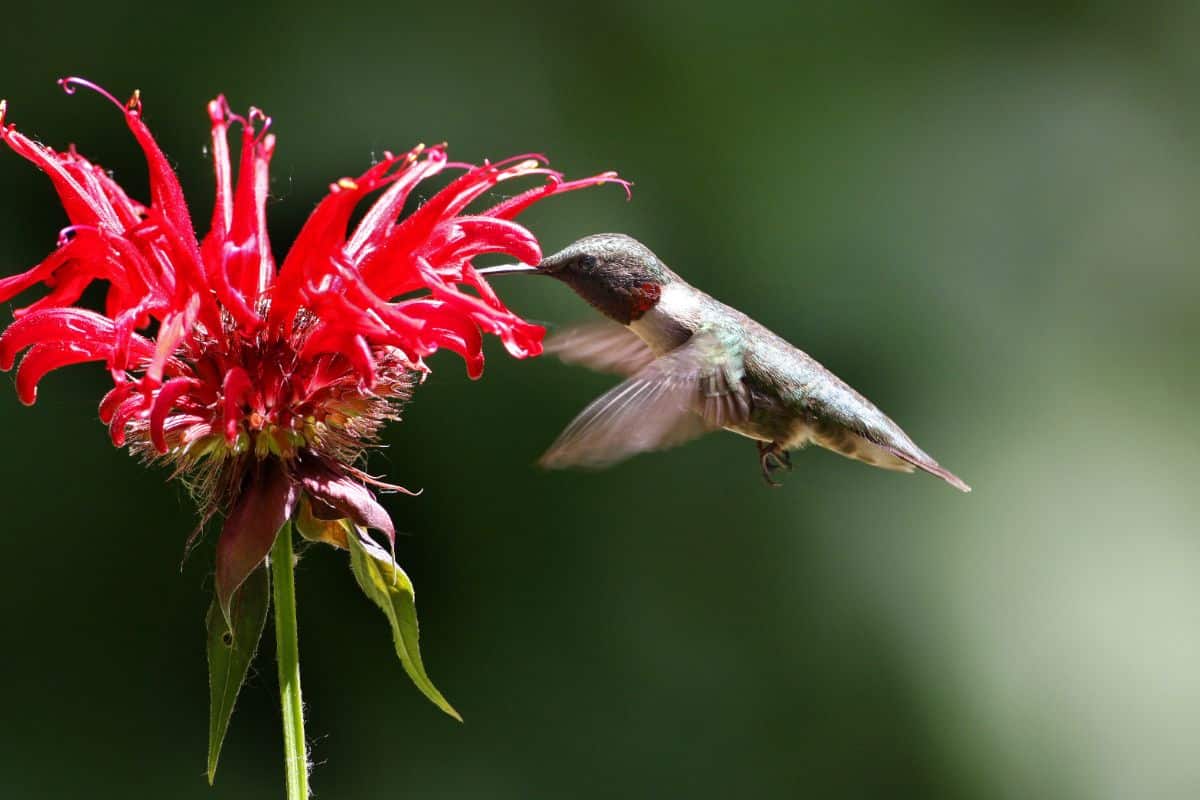
| Plant name: | Bee balm |
| Light requirements: | Full sun |
| Water requirements: | Moderate |
| Perennial or annual? | Perennial |
| Growing zone: | Zones 3 to 9 |
Bee balm is hard to miss, with colorful, spiky flowers that appear at the top of tall and slender stems. Flower petals are often bright pink, but they come in red, purple, and white as well. Bee balm is available in both standard and dwarf sizes and ranges in height from 1 to 4’ tall, making them well-suited to both container gardens and inground beds alike.
Many different pollinators are drawn to bee balm, including bees, but hummingbirds are particularly attracted to their colorful flowers and rich nectar. Bee balm is also edible to humans and is often used in herbal tea blends. These plants are quite hardy and drought tolerant, but they should be planted with adequate airflow between their leaves to prevent issues like powdery mildew.
3. Cardinal flower (Lobelia cardinalis)
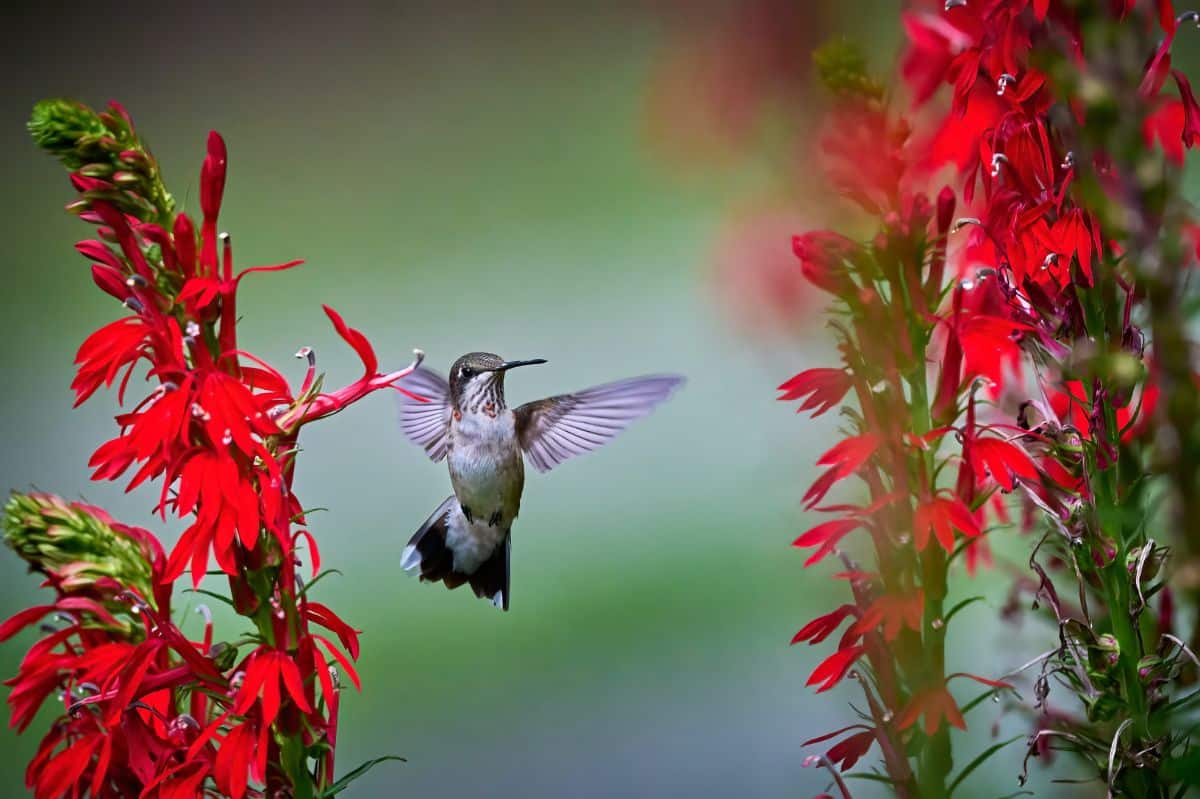
| Plant name: | Cardinal flower |
| Light requirements: | Full sun (in cool regions) to shade |
| Water requirements: | High |
| Perennial or annual? | Perennial |
| Growing zone: | Zones 3 to 9 |
The Cardinal flower is native to the Americas, where it can be found growing in moist areas, such as along streambanks. In the garden, this water-loving plant should be kept well mulched to keep its soil from drying out and to protect its tender roots from the worst of winter weather.
Named for its bright red petals, which are reminiscent of a cardinal’s colorful robes, cardinal flowers begin blooming in July and continue their showstopping display well into early autumn. Flowers are tubular in form, making them just the right shape for browsing hummingbirds to feed from. Plants grow to about 3 to 4’ in height, making them ideal plants for mid-garden sowing.
4. Beardtongue (Penstemon spp.)
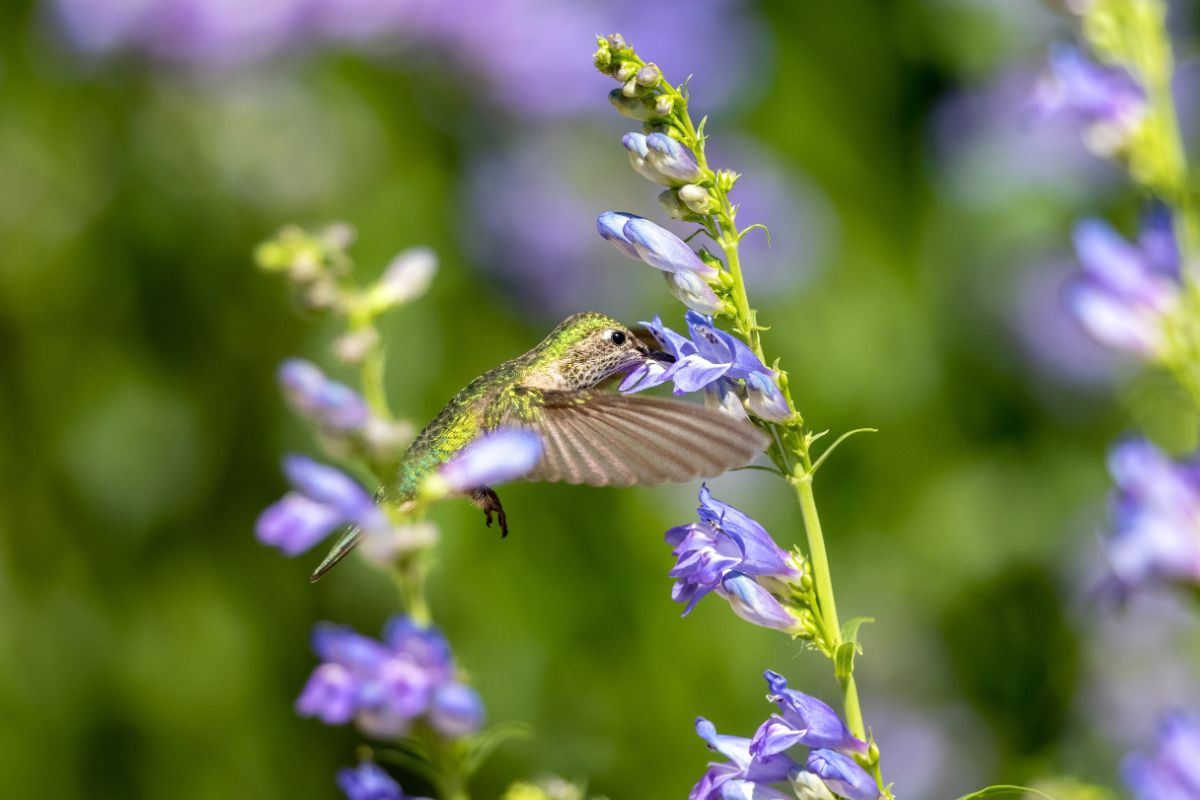
| Plant name: | Beardtongue |
| Light requirements: | Full sun |
| Water requirements: | Moderate to low |
| Perennial or annual? | Perennial |
| Growing zone: | Zones 3 to 8 |
Beardtongues are another excellent flowering plant for hummingbirds, and they are well-known for their tubular flowers that come in a wide range of colors. While you can find beardtongue blooms in white, purple, and blues, cultivars with red or pink flowers tend to be the best choices if you want to attract hummingbirds.
Native to North America, beardtongues are easy-going plants that grow between 1 and 4’ tall. Ideal for front to mid-garden planting, beardtongues grow best in full sun, and they need well-draining soil as their roots can be prone to rot.
5. Catmint (Nepeta x faassenii)
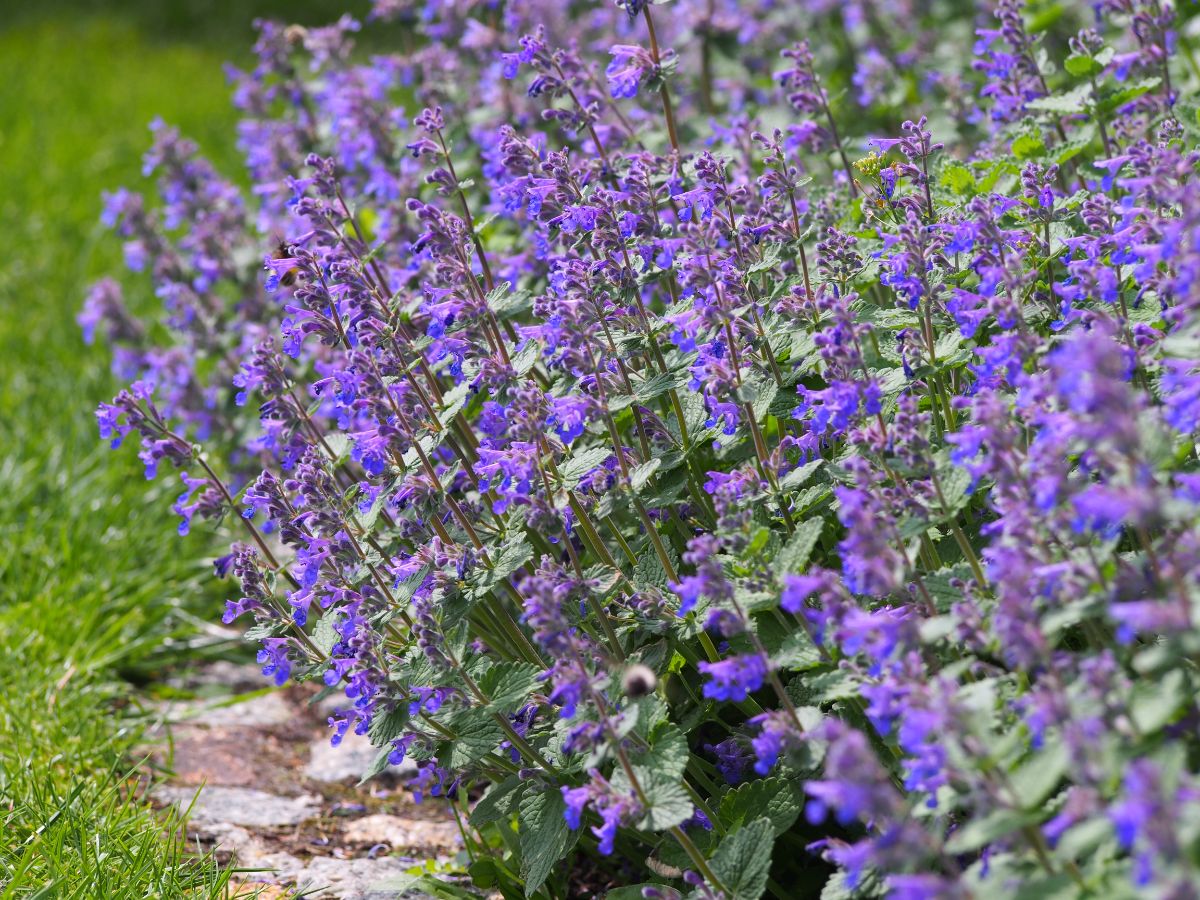
| Plant name: | Catmint |
| Light requirements: | Full sun to partial shade |
| Water requirements: | Moderate to low |
| Perennial or annual? | Perennial |
| Growing zone: | Zones 3 to 8 |
Catmint and catnip look quite similar, and they are closely related plants; however, catmint is not as stimulating to cats. This plant is very popular with hummingbirds, though, and is sure to bring in other pollinators to your garden as well!
Catmint grows between 1 to 3’ high and produces tall spikes of blue to purple flowers that look absolutely stunning in cottage gardens and pollinator gardens alike. Flowers are long-lasting, while the plant itself is very heat and drought-tolerant. Catmint is a fine choice if you’re looking for a no-fuss plant!
6. Verbena (Verbena spp.)
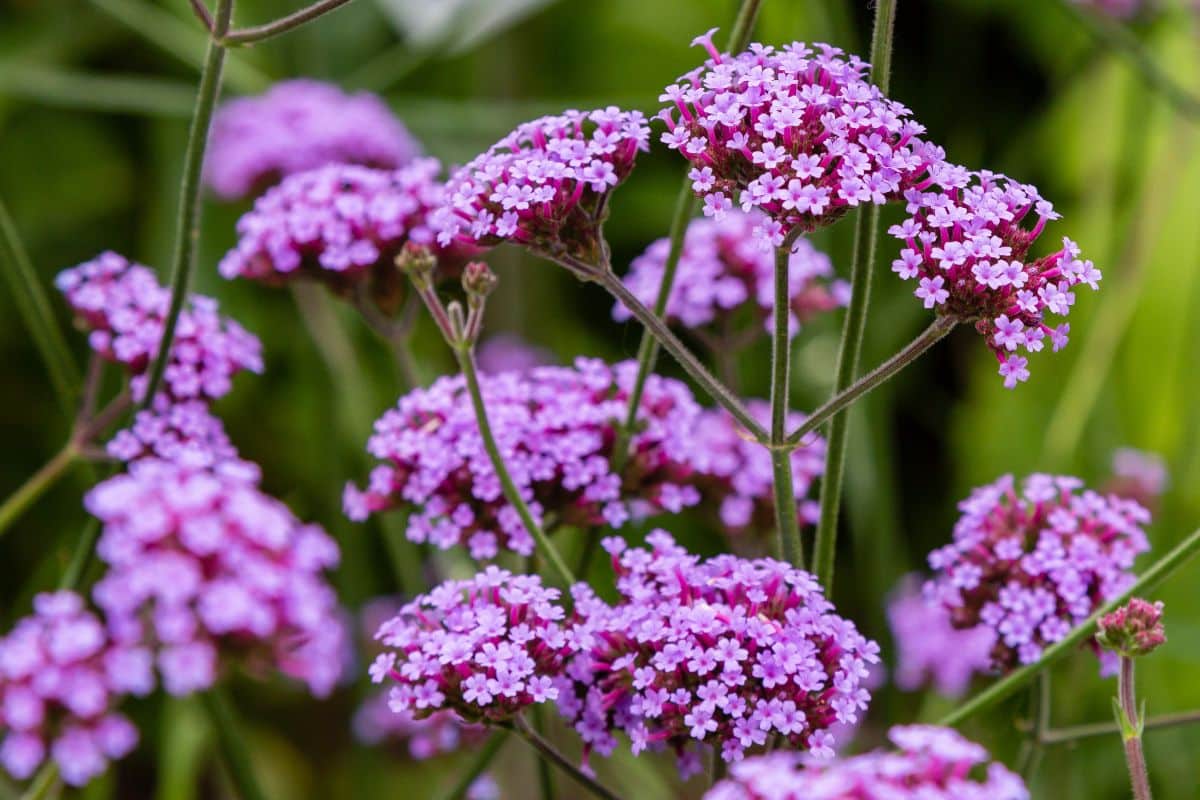
| Plant name: | Verbena |
| Light requirements: | Full sun |
| Water requirements: | Moderate |
| Perennial or annual? | Both |
| Growing zone: | Zones 8 to 11 |
Also known as vervain, verbena are low-maintenance plants with showy clusters of flowers in pinks, blues, purples, and other hues. There are over 250 different species of verbena, so there is a lot of variety to choose from. Some verbena types are hardy perennials, but many are annuals that should be planted every spring or summer.
Taller cultivars of verbena can be used in inground beds or planters as centerpiece plants; however, you can also find spreading verbena varieties that make wonderful groundcovers. Verbenas grow best in rich, well-draining soil that has been amended with a bit of compost prior to planting.
7. Daylily (Hemerocallis spp.)
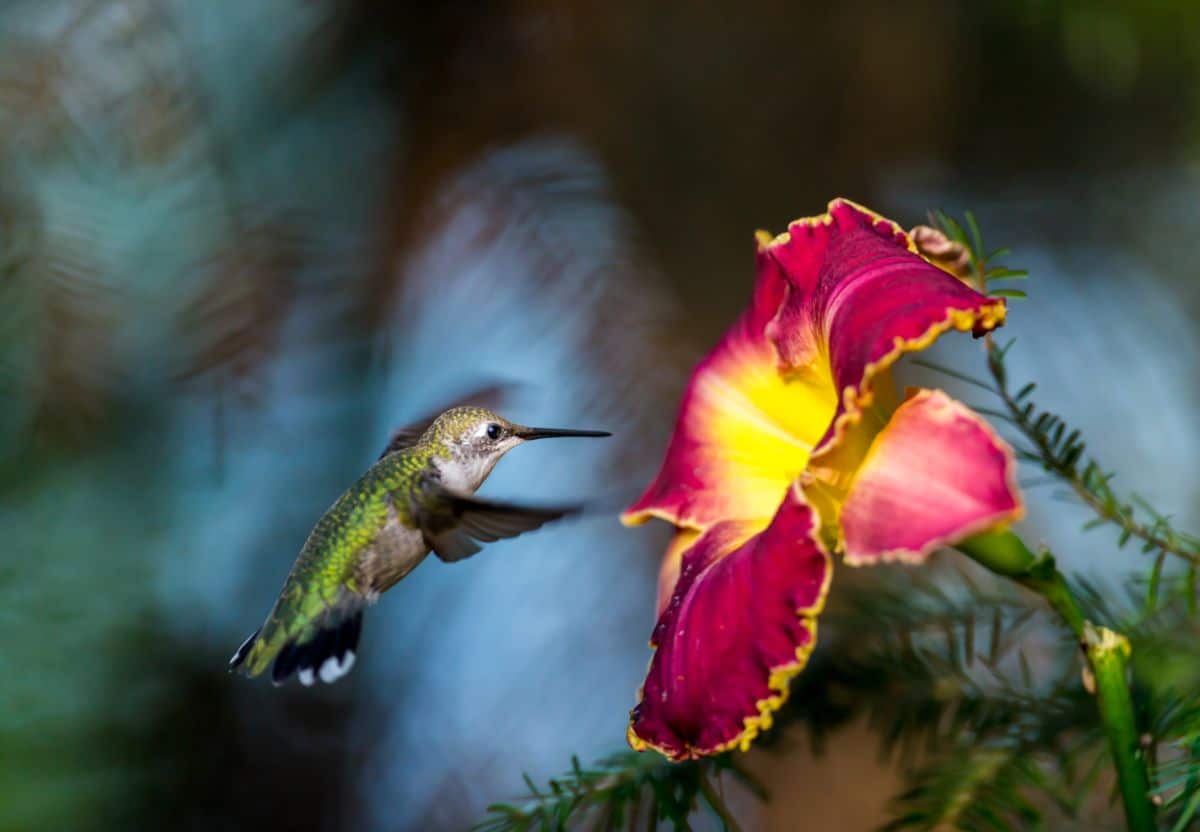
| Plant name: | Daylily |
| Light requirements: | Full sun to partial shade |
| Water requirements: | Moderate |
| Perennial or annual? | Perennial |
| Growing zone: | Zones 2 to 11 |
Many of the top plants for hummingbirds grow best in full sun, but if you have a shady yard and you still want to create a pollinator garden, there are a few flowers that work quite well. Daylilies are one top choice for hummingbird gardens, and they can even thrive in part shade.
Despite their name, daylilies are not true lilies, although their flower structure is similar in form. Bright orange flowers bloom in mid-summer and benefit from frequent deadheading, which will help your plants continue to look their best throughout the growing season. Like many other perennials, daylilies should be divided every 3 to 5 years to prevent plants from getting overcrowded.
8. Petunia (Petunia spp.)
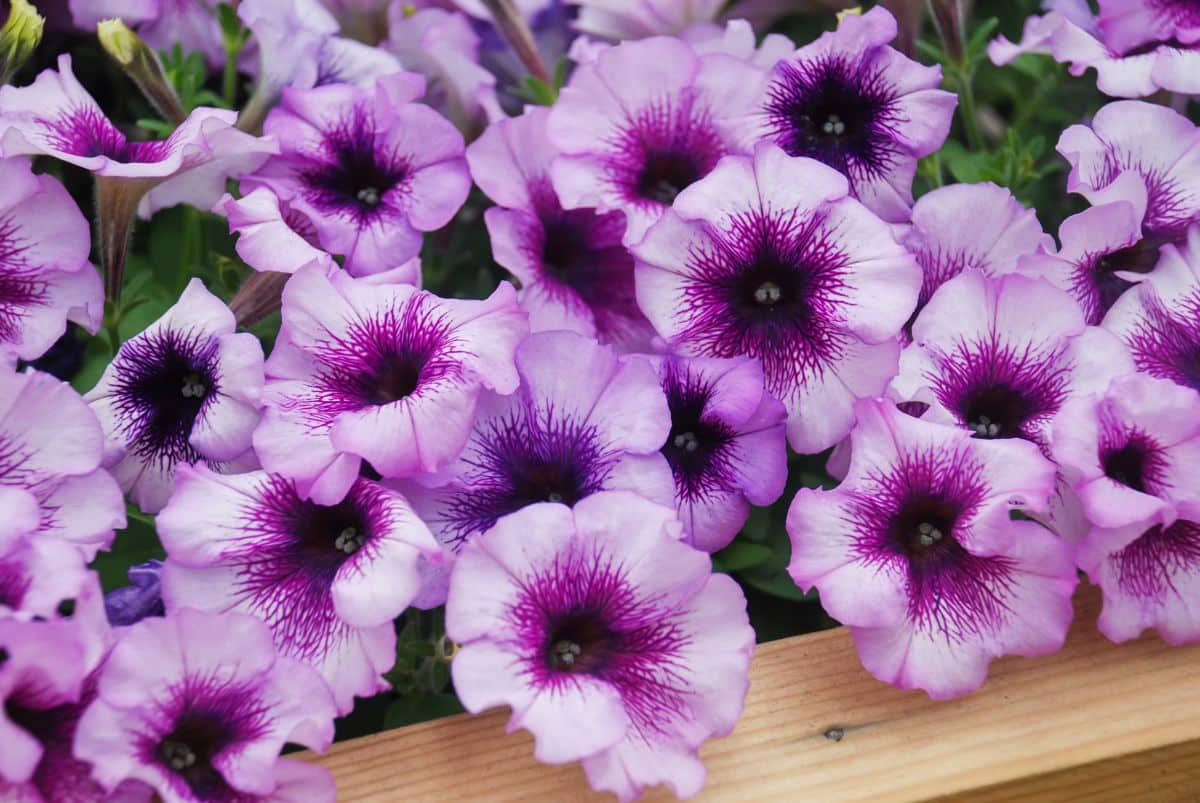
| Plant name: | Petunia |
| Light requirements: | Full sun |
| Water requirements: | High to moderate |
| Perennial or annual? | Perennial in warm locations, often grown as annuals |
| Growing zone: | Zones 9 to 11 |
One of the most popular ornamental flowers among home gardeners, petunia’s small size and trailing growth habit, make them common choices for small space gardens and hanging planters. These trumpet-shaped flowers are also very attractive to hummingbirds and are generally very easy plants to find, even if your local plant nursery has a limited selection of other pollinator plants.
Petunias are generally kept as annuals, although they are technically classified as “tender perennials,” which can be overwintered in warmer locations. Interestingly, these plants are members of the nightshade family, which also includes tomatoes and potatoes.
9. Tall phlox (Phlox paniculata)
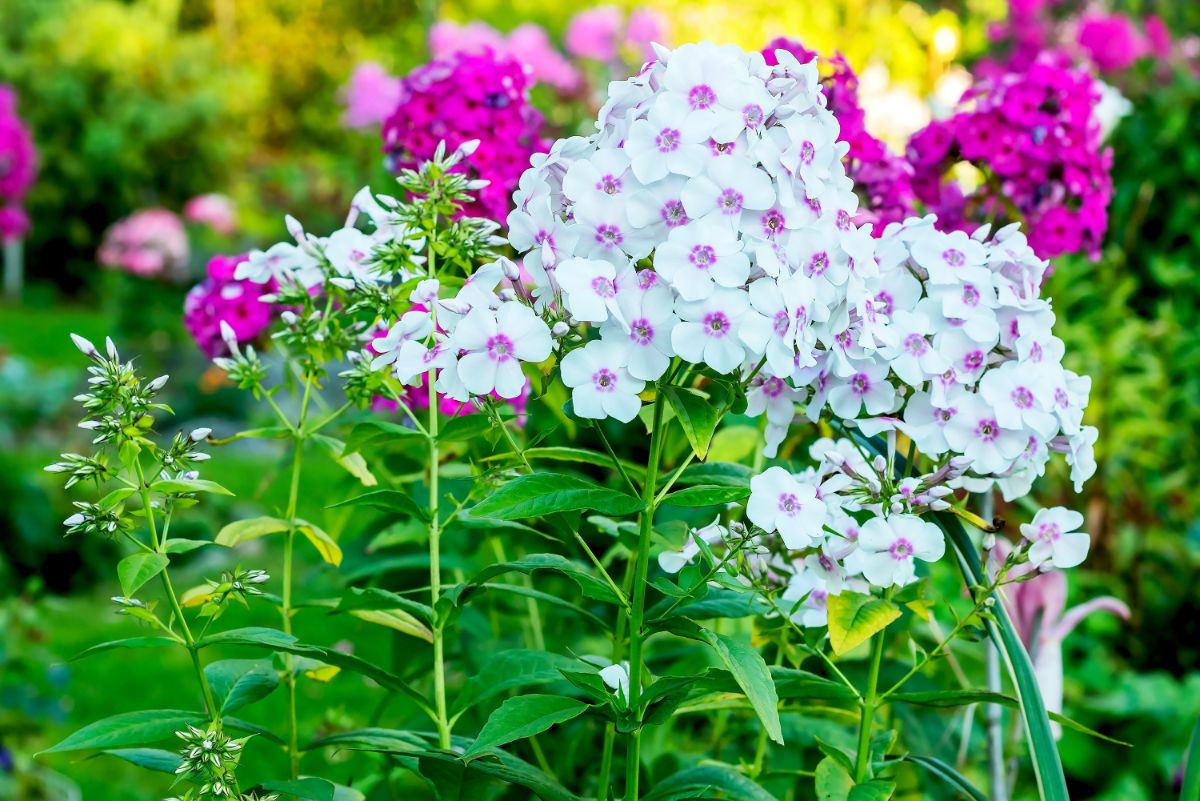
| Plant name: | Tall phlox |
| Light requirements: | Full sun |
| Water requirements: | Moderate |
| Perennial or annual? | Perennial |
| Growing zone: | Zones 4 to 8 |
Creeping phlox is an early spring bloomer that grows low to the ground and is a very pretty groundcover. Later in the season, tall phlox comes into bloom, which boasts similarly delicate flowers; however, these plants make a greater impact in garden beds thanks to their height.
Tall phlox flowers come in pink, purple, white, and other colors, and they exude a sweet, floral fragrance that is sure to uplift your spirits when you’re taking an after-dinner stroll in your garden. As a pollinator plant, tall phlox will lure in hummingbirds, bees, and butterflies, and it makes a lovely cut flower too. Just keep in mind that phlox can be susceptible to mildew, so be sure to always water your plants at the soil line.
10. Trumpet vine (Campsis radicans)
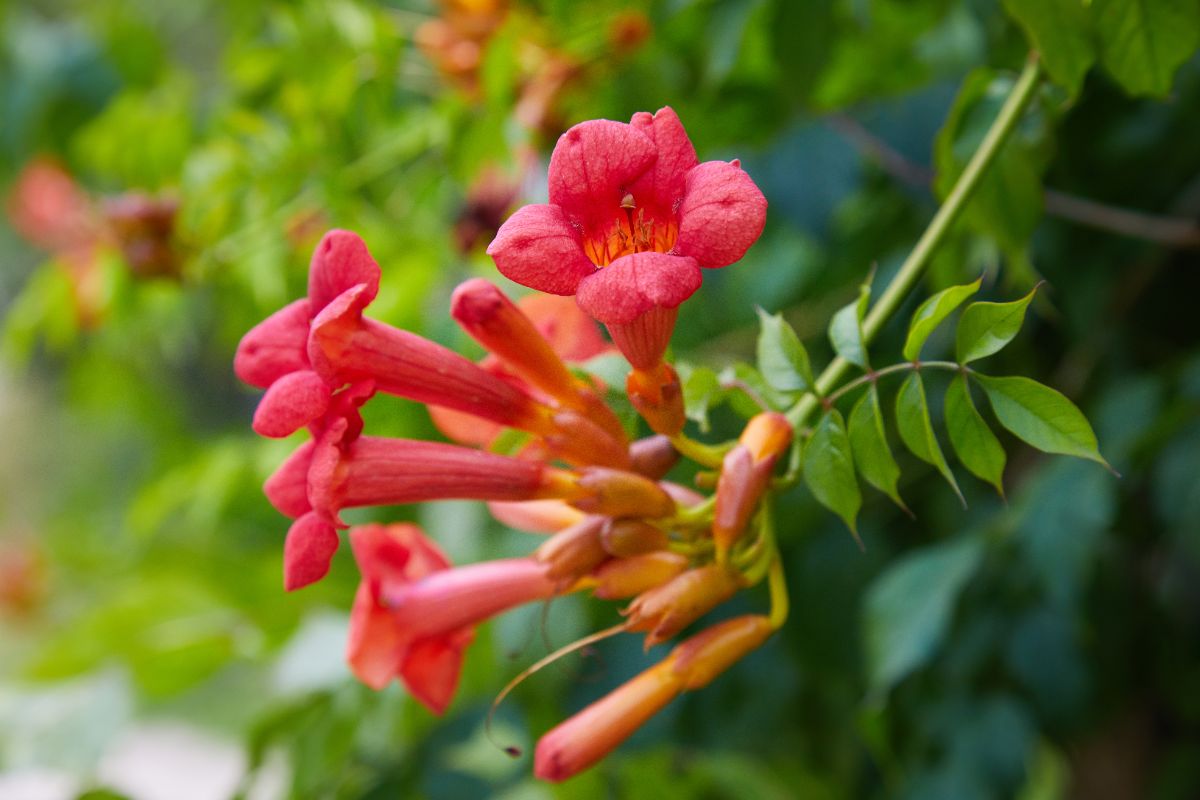
| Plant name: | Trumpet vine |
| Light requirements: | Full sun to partial shade |
| Water requirements: | Moderate |
| Perennial or annual? | Perennial |
| Growing zone: | Zones 4 to 9 |
Trumpet vines are impressive-looking plants with large, trumpet-shaped flowers that can grow between 1 to 3” long. Flowers can be found in yellow, orange, or red, which are some of the best colors for attracting hummingbirds! These vibrant blooms appear in summer, while the vine itself develops bright yellow leaves in autumn for even more garden color.
While trumpet vines are native to North America, they can spread aggressively, so you’ll want to keep your vines well-pruned to keep them from taking over. A mature trumpet vine can stretch over 40’ and will need sturdy trellising to keep it well-supported.
11. Foxglove (Digitalis spp.)
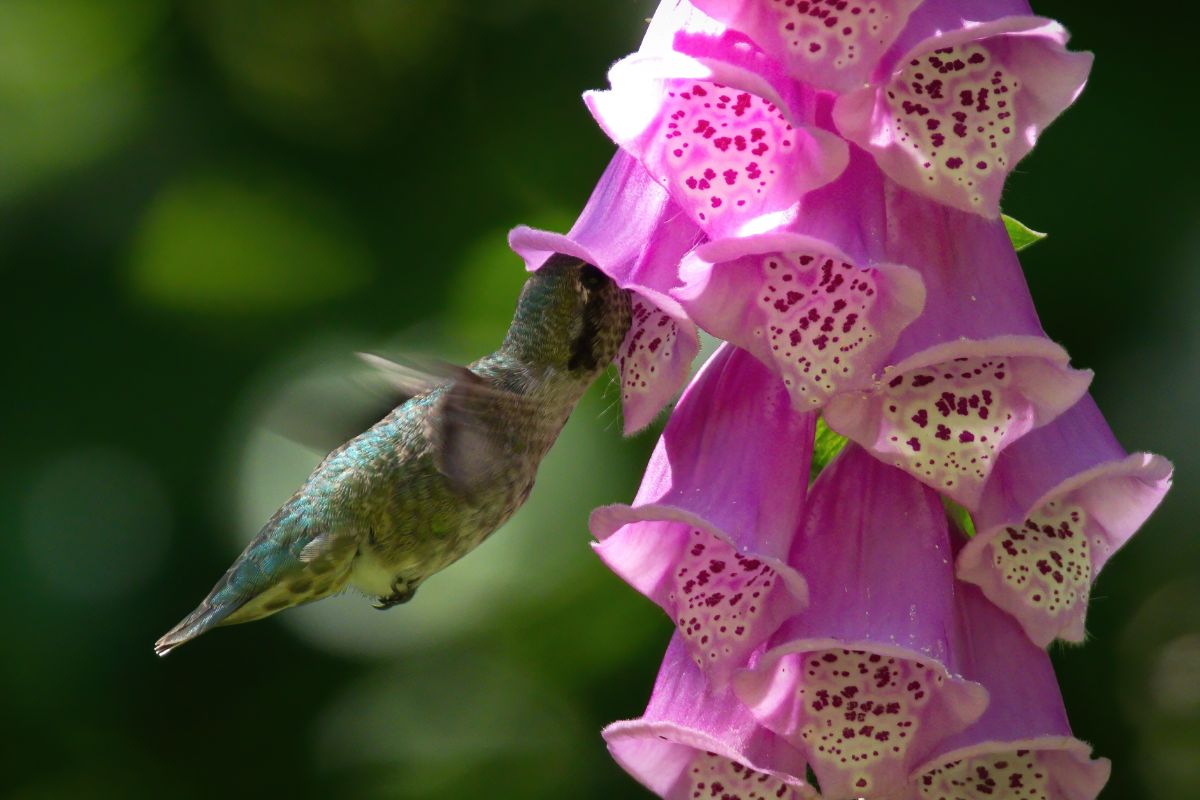
| Plant name: | Foxglove |
| Light requirements: | Full sun to partial shade |
| Water requirements: | Moderate |
| Perennial or annual? | Perennial |
| Growing zone: | Zones 4 to 9 |
Foxgloves have a magical look to them when they bloom in early summer, producing tall spires of tubular flowers that are often ornamented with fine speckling. Commonly, flowers come in pinks and purples, but other colors are available too. These plants are sometimes included in wildflower mixes, but they can be easily grown from seeds or nursery starts as well.
Foxgloves are adaptable plants that can handle sun or part shade, so they’re a good choice if your yard doesn’t get a lot of sun. Hummingbirds will be drawn to the tubular flowers, even if you sow these plants in pots. Just be aware that these plants are quite toxic to humans and pets if ingested.
12. Flowering tobacco (Nicotiana spp.)
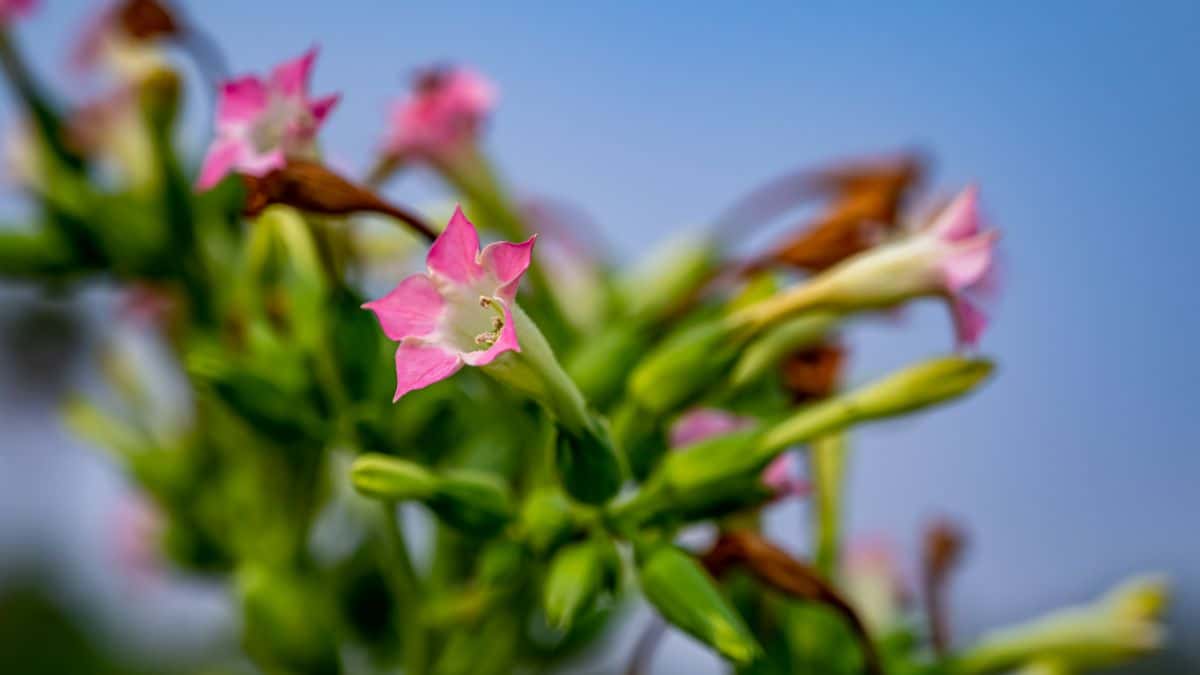
| Plant name: | Flowering tobacco |
| Light requirements: | Full sun to partial shade |
| Water requirements: | Moderate |
| Perennial or annual? | Perennial in warm locations, often grown as annuals |
| Growing zone: | Zones 10 to 11 |
Flowering tobacco is not the sort of tobacco you’d find in a cigar, but it is an exceptional pollinator plant that hummingbirds just can’t resist. Long flowers are highly fragranced and come in a range of colors, including pink, red, and white. Flowers often bloom at night, making them top choices for moon gardens, although plants look lovely in daylight too!
Flowering tobacco is a member of the nightshade family, which also contains petunias, tomatoes, and peppers. For this reason, you may not want to sow these plants near your other nightshade plants, as these plants can be susceptible to some of the same pests and diseases.
13. Pineapple sage (Salvia elegans)
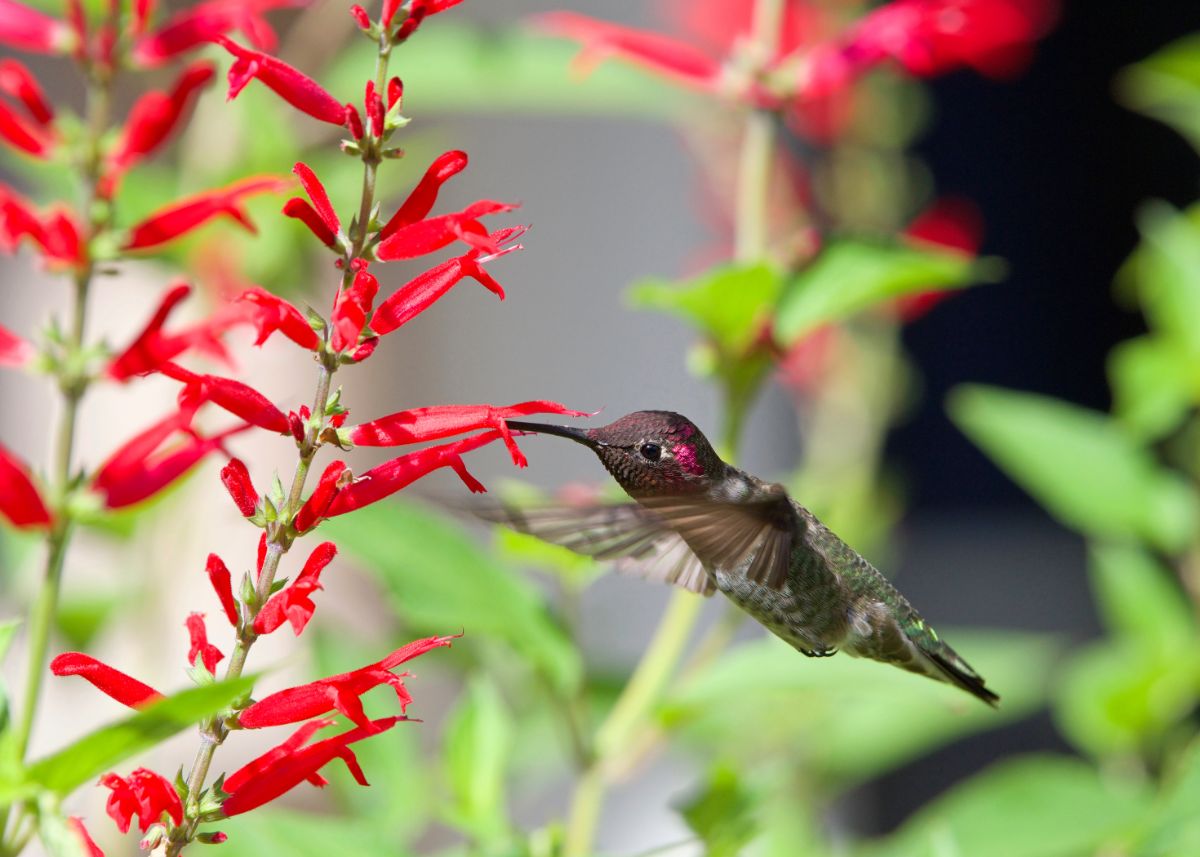
| Plant name: | Pineapple sage |
| Light requirements: | Full sun |
| Water requirements: | Moderate |
| Perennial or annual? | Perennial in warm locations, often grown as annuals |
| Growing zone: | Zones 8 to 11 |
Not to be confused with traditional culinary sage, pineapple sage produces fiery red flowers that are hard to miss in garden beds and ornamental containers. Named for its delightful fragrance that has notes of fruit and sage, pineapple sage is edible to humans, but it really excels as a pollinator plant. Especially since its tubular flowers are perfectly formed for hummingbirds’ long beaks!
Pineapple sage blooms later in the season than many of the other plants on this list, making it an ideal food source for hummingbirds as they prepare for their autumn migration. Pineapple sage is a warm weather-loving plant and is only hardy to zone 8. However, it can be kept in planters and overwintered indoors if you live in a cooler location.
14. Delphinium (Delphinium spp.)
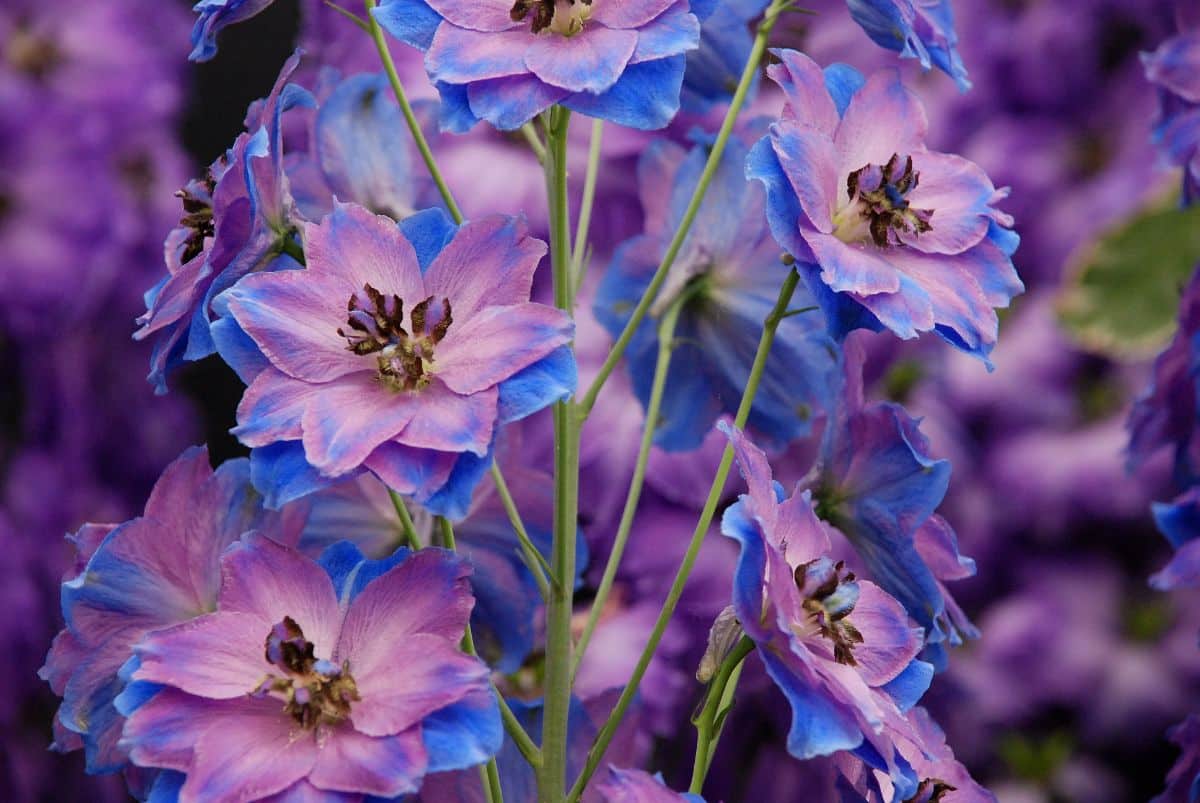
| Plant name: | Delphinium |
| Light requirements: | Full sun |
| Water requirements: | Moderate |
| Perennial or annual? | Perennial |
| Growing zone: | Zones 2 to 11 |
Also known as larkspur, delphinium is a crowd favorite known for its vibrantly colored blue flowers that form atop long spires. Each spire produces a wealth of blooms, so hummingbirds will have plenty of nectar to forage from if you choose to plant these flowers. They also dry beautifully and make excellent pressed flowers too!
There are over 300 different species of delphinium, including some perennial and annual options. While delphiniums are most often blue in color, you can find delphiniums in other colors as well, including purple and white. Plants can be grown from seed or nursery starts, but seeds will germinate best with cold stratification.
15. Eastern red columbine (Aquilegia canadensis)
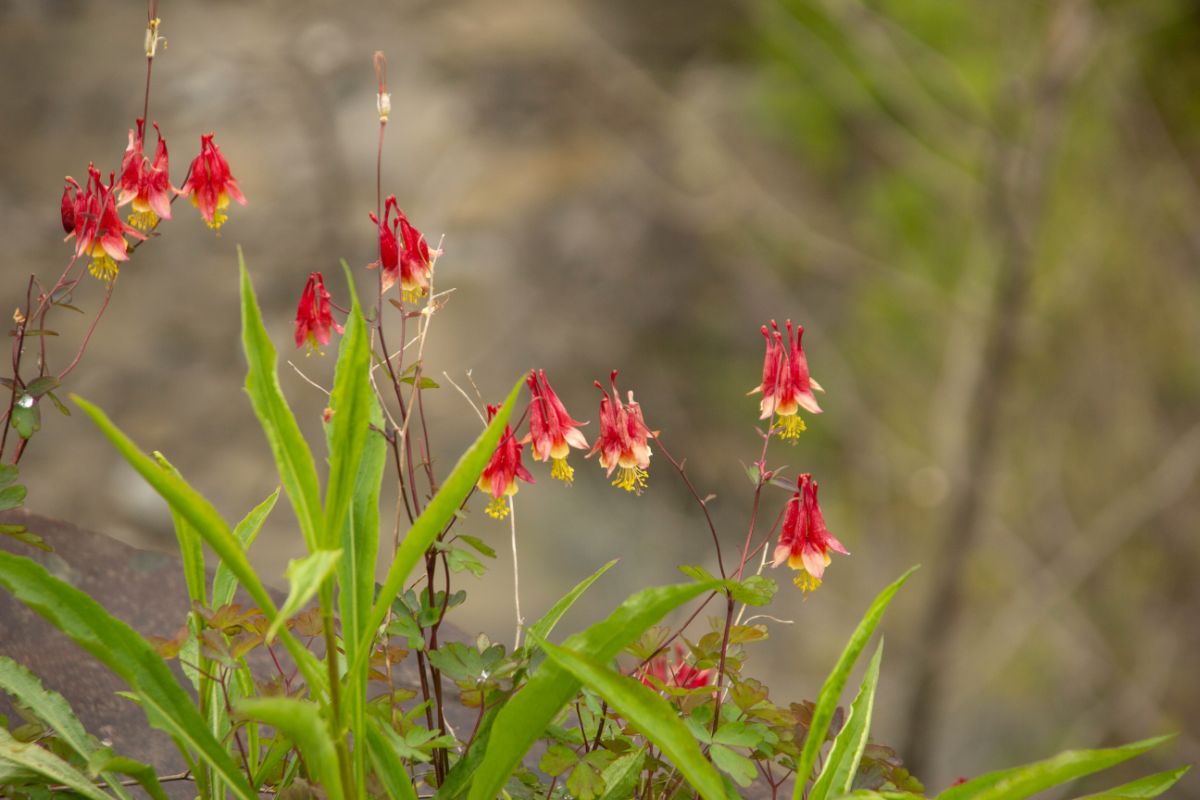
| Plant name: | Eastern red columbine |
| Light requirements: | Full sun to partial shade |
| Water requirements: | Moderate |
| Perennial or annual? | Perennial |
| Growing zone: | Zones 3 to 8 |
There’s a wide variety of columbine plants to choose from, but one of my favorites is the Eastern red columbine. This variety is native to North America and is known for its showy red and yellow blooms, which makes it particularly alluring to hummingbirds. For a truly stunning arrangement, try planting Eastern red columbine with nasturtiums – another top pollinator plant!
Eastern red columbines are early bloomers, with flowers appearing from May to June. Flowers have a spiky form and develop at the end of long, slender stems that give the plant a delicate, airy appearance. These plants also readily seed themselves, which is good news as these plants begin to fade after a few years.
16. Zinnia (Zinnia elegans)
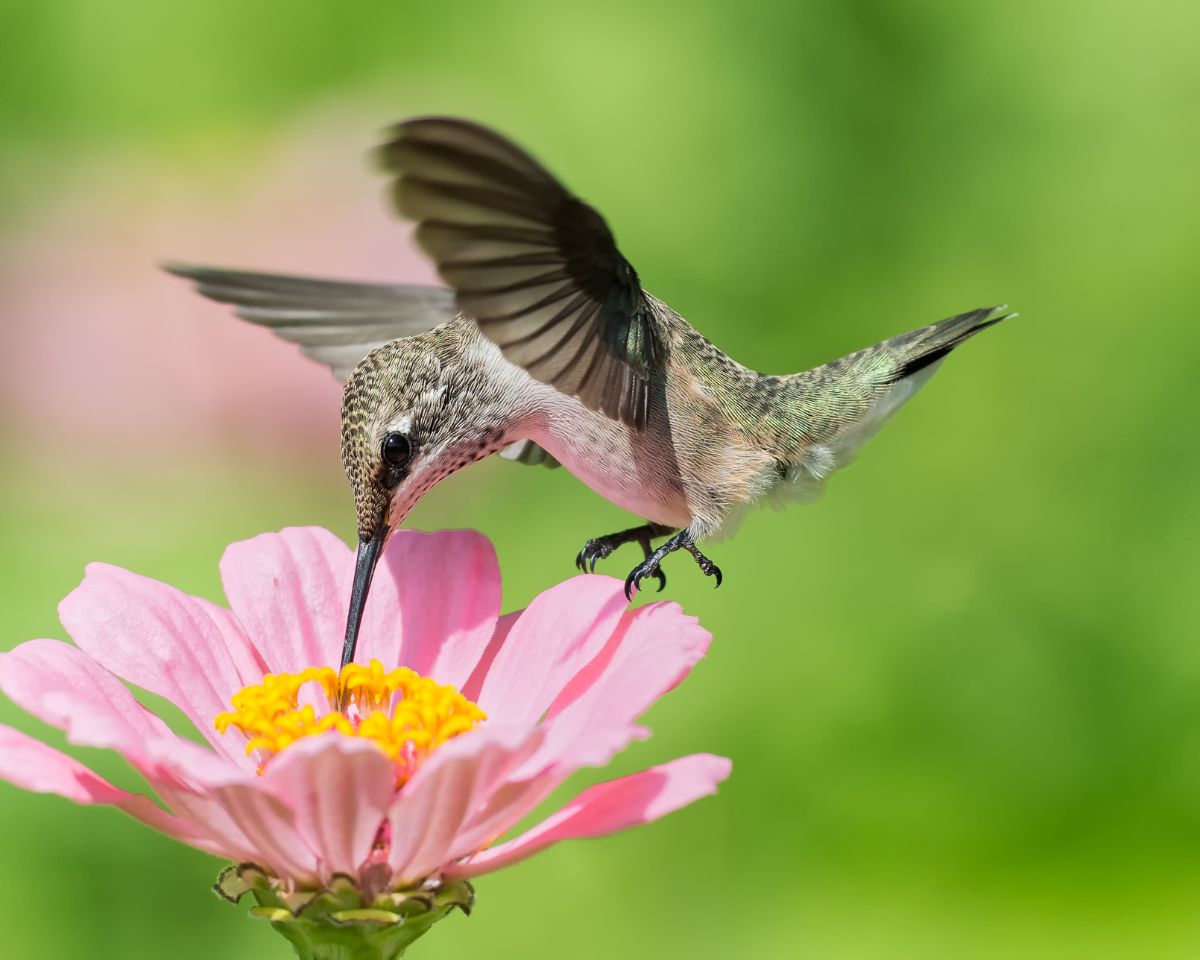
| Plant name: | Zinnia |
| Light requirements: | Full sun |
| Water requirements: | High to moderate |
| Perennial or annual? | Annual |
| Growing zone: | Zones 3 to 10 |
It’s no wonder why zinnias are such popular plants. They come in just about every color you could want, and they range in size and form. However, if you’re goal is to attract hummingbirds, look for single-bloom zinnia varieties, as the nectar in double-bloom zinnias can be difficult for pollinators to access.
Zinnias can be easily grown from seed, and they are just the right size for container gardens or inground beds. Many gardeners keep zinnias for natural pest control as well, as they attract predatory insects to your garden that feed on plant pests.
17. Bleeding heart (Lamprocapnos spectabilis)
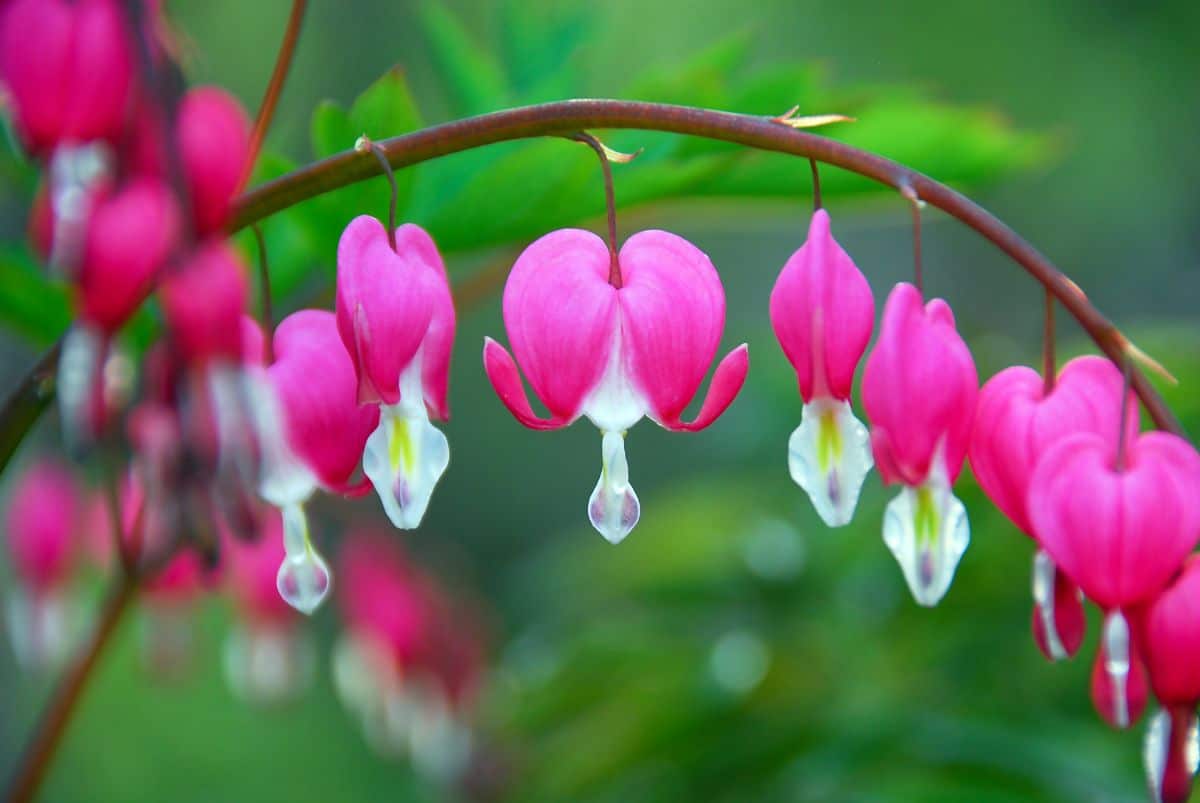
| Plant name: | Bleeding heart |
| Light requirements: | Full sun (in cool climates) to partial shade |
| Water requirements: | Moderate |
| Perennial or annual? | Perennial |
| Growing zone: | Zones 3 to 9 |
At first glance, bleeding hearts’ unusually shaped flowers may not be an obvious choice for a hummingbird garden, but hummingbirds love these plants! Because bleeding hearts bloom in early spring, they’re an important source of food for many different pollinators since most flowers are not in bloom at this time. As summer temperatures rise, bleeding hearts begin to die back, but they will come back year after year.
Most commonly, you’ll find bleeding hearts with pink flowers, but you can also find solid white varieties that are truly stunning. Bleeding hearts can be purchased at plant nurseries, or you can order rootstock online and plant it in early spring. These adaptable plants can be grown in shade or full sun, as long as you give them plenty of water.
18. Hosta (Hosta spp.)
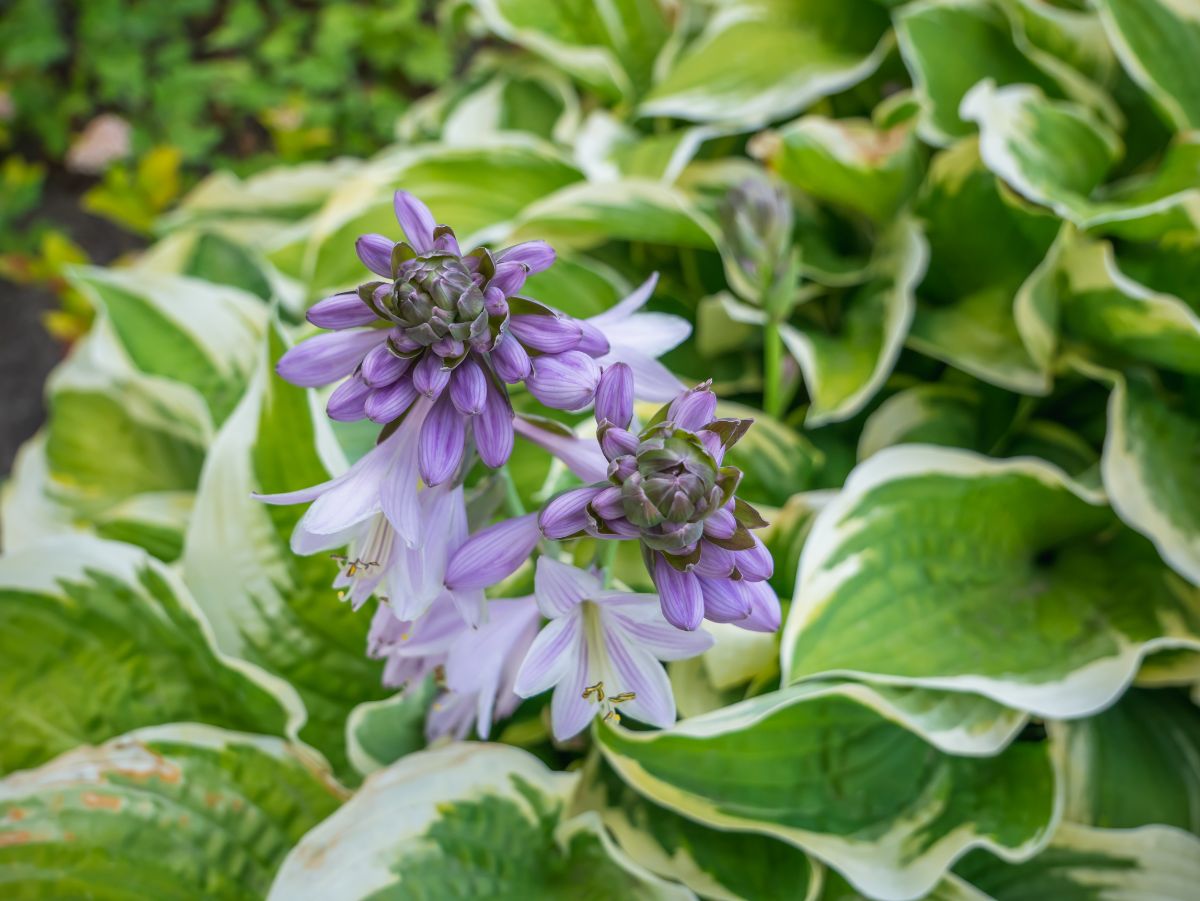
| Plant name: | Hosta |
| Light requirements: | Shade |
| Water requirements: | Moderate |
| Perennial or annual? | Perennial |
| Growing zone: | Zones 3 to 9 |
Another shade-loving plant, hostas are mostly kept for their patterned foliage, but they produce tubular flowers atop long stalks. Flowers can be purple or white in tone and generally appear from May to September, depending on the variety of hosta you’re growing.
Hostas come in all different shapes and sizes -- from the large ‘Empress Wu’ hosta that can stretch over 6’ wide to smaller dwarf varieties. Hostas grow best when provided with some shade, as they can be susceptible to sunscald. Hostas are also often targeted by slugs and snails, so you may want to add some ‘slug pubs’ to your garden if you choose to grow these plants.
19. Salvia (Salvia spp.)
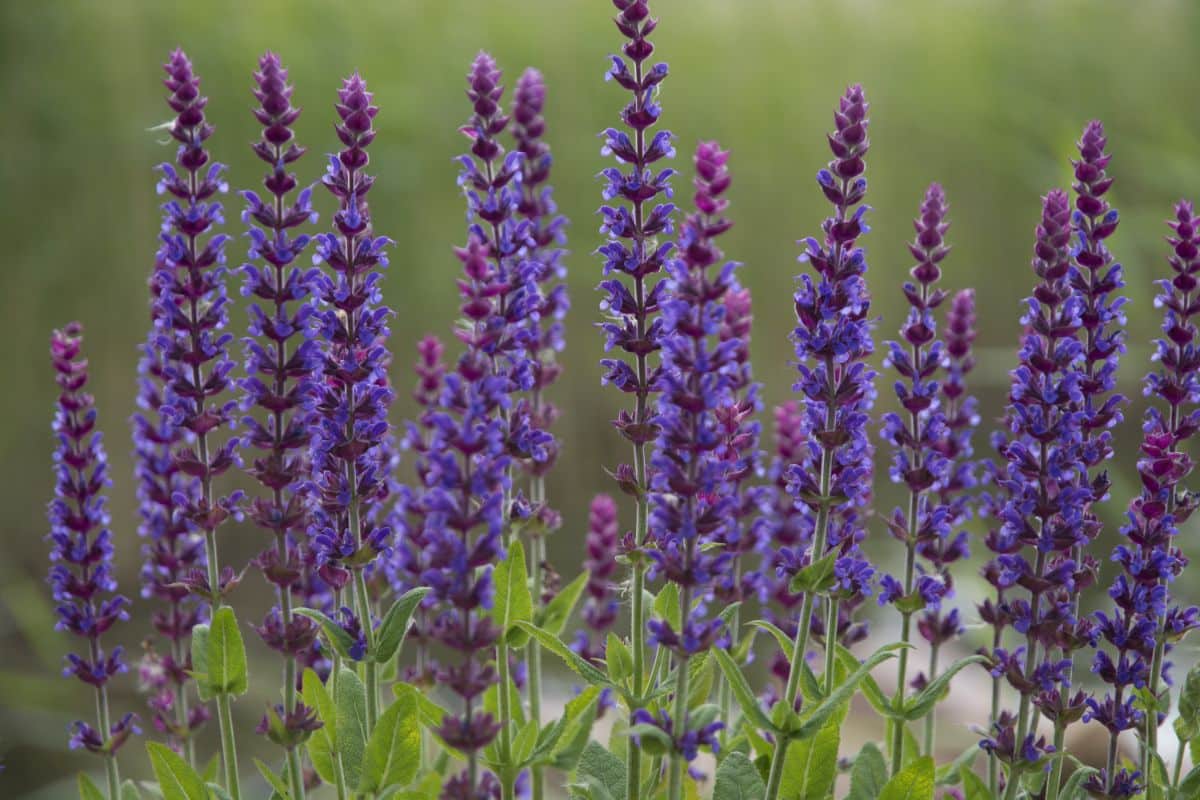
| Plant name: | Salvia |
| Light requirements: | Full sun |
| Water requirements: | Moderate |
| Perennial or annual? | Both |
| Growing zone: | Zones 5 to 9 |
There are many different salvias on the market today, but all of them are popular with hummingbirds and other pollinators. Both annual and perennial salvia varieties can be added to your garden beds, and there are lots of different colors to choose from, including purple, orange, and red.
Salvias are easy-to-care-for plants that are particularly treasured for their hardy nature and drought tolerance. Plant salvia in full sun to partial shade, and make sure your plant has well-draining soil, as these plants don’t do well in soggy beds.
20. Red hot poker (Kniphofia uvaria)
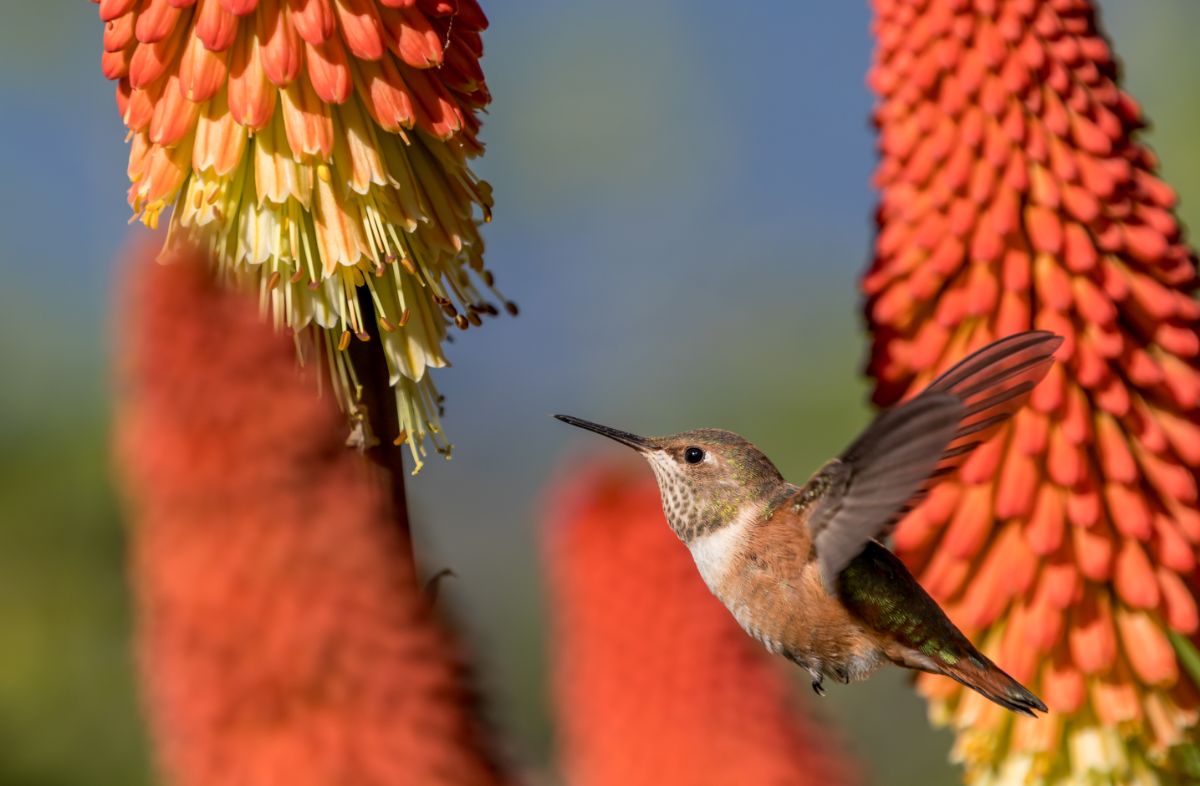
| Plant name: | Red hot poker |
| Light requirements: | Full sun |
| Water requirements: | Moderate |
| Perennial or annual? | Perennial |
| Growing zone: | Zones 6 to 9 |
Aptly named red hot pokers feature bright spires of orange and red flowers that are truly one of a kind. These dramatic plants can grow up to 4’ high and make wonderful mid-garden choices, or they can form a stunning backdrop when paired with shorter-growing plants, like petunias and nasturtium.
Flowers bloom in early summer and provide a wealth of food for hummingbirds and other visiting pollinators. Just be sure to provide your plants with lots of sun and plant them in well-draining soil to avoid issues like root rot. Also known as “torch lilies,” red hot pokers are native to Africa, but they can be grown in locations as cool as zone 6.
21. Anise hyssop (Agastache foeniculum)
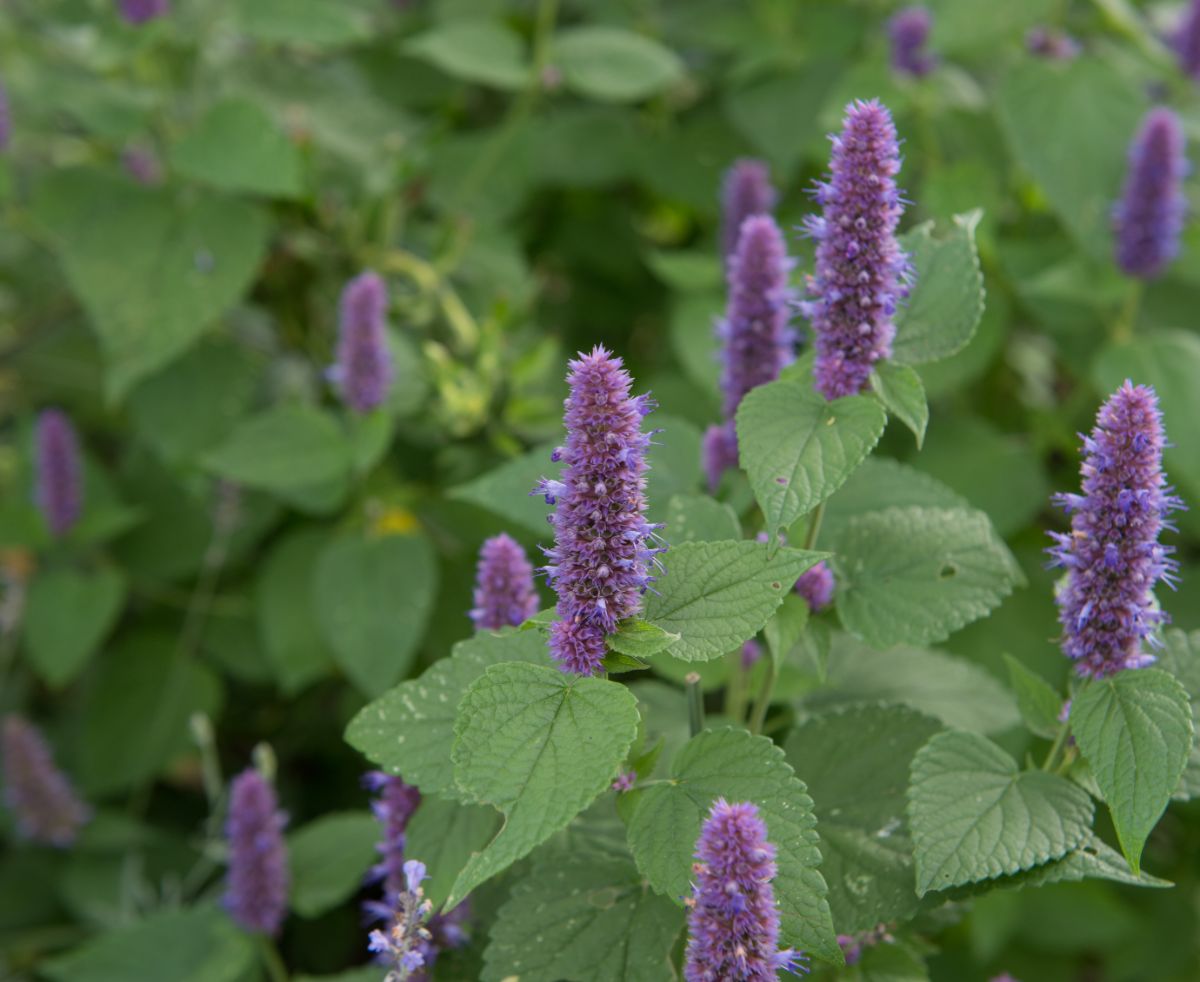
| Plant name: | Anise hyssop |
| Light requirements: | Full sun |
| Water requirements: | Moderate to low |
| Perennial or annual? | Perennial |
| Growing zone: | Zones 4 to 8 |
Many different types of Agastache are well-suited for hummingbird gardens, but anise hyssop is a particularly charming option that grows well in the cool, wet climates of North America. This fragrant plant is a member of the mint family and produces tall spires of purple flowers that create beautiful swathes of vibrant color when planted closely together. Just keep in mind these plants can spread, like other varieties of mint!
In addition to its usefulness in pollinator gardens, anise hyssop is commonly used as an herbal tea or seasoning. This plant has an anise or licorice-like flavor and is often added to homemade potpourri recipes too!
22. Trumpet honeysuckle (Lonicera sempervirens)
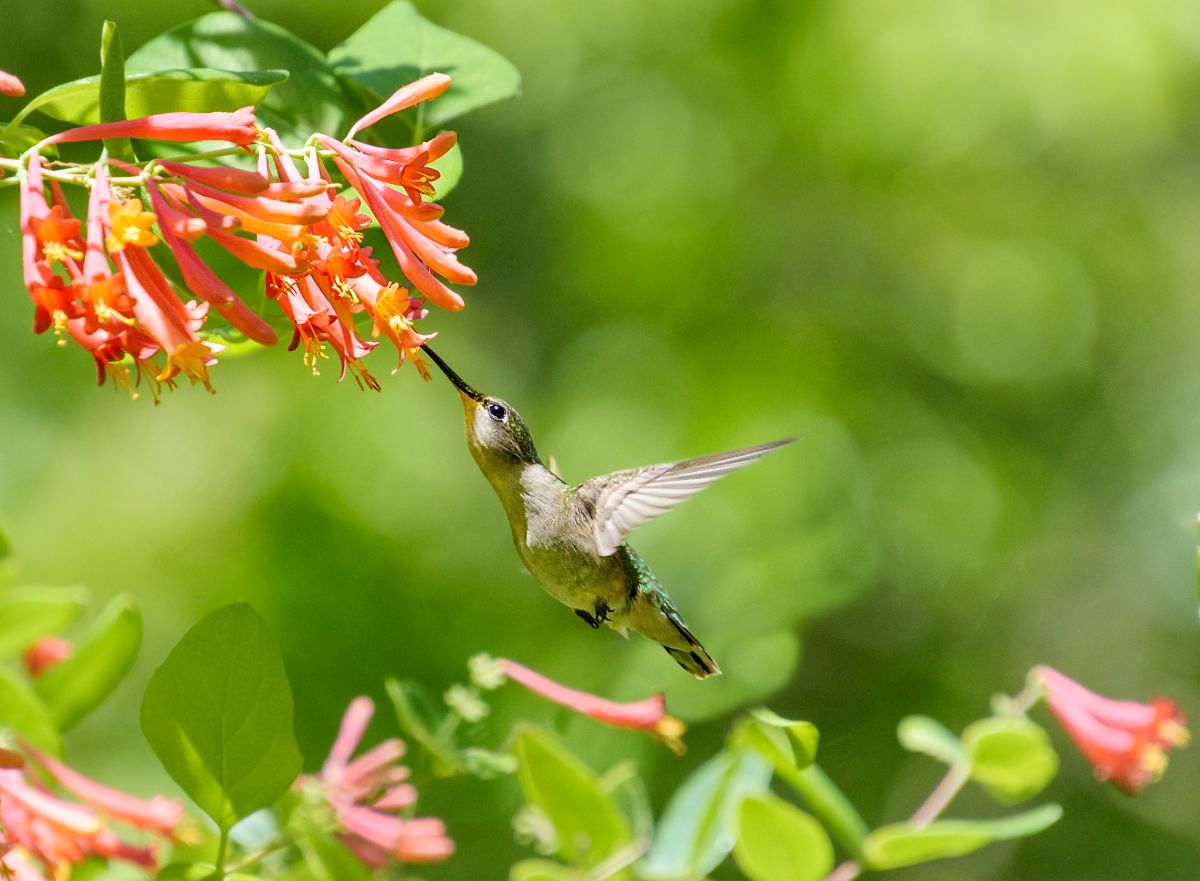
| Plant name: | Trumpet honeysuckle |
| Light requirements: | Full sun |
| Water requirements: | Moderate |
| Perennial or annual? | Perennial |
| Growing zone: | Zones 3 to 9 |
Some types of honeysuckle can become invasive, so it’s best to take precautions when slowing these plants. That said, trumpet honeysuckle tends to be an easier-to-manage variety, but you can choose to keep it well-pruned if you desire. Left on its own, trumpet honeysuckle vines will grow between 10 and 20’ long and will require trellising or other supports to grow properly.
Hummingbirds can’t resist the colorful flowers and high nectar content of these attractive vines. Trumpet honeysuckle is highly adaptable and can grow in both full sun and part shade. Flowers first appear in spring, but vines may continue to bloom on and off through fall.
Summary
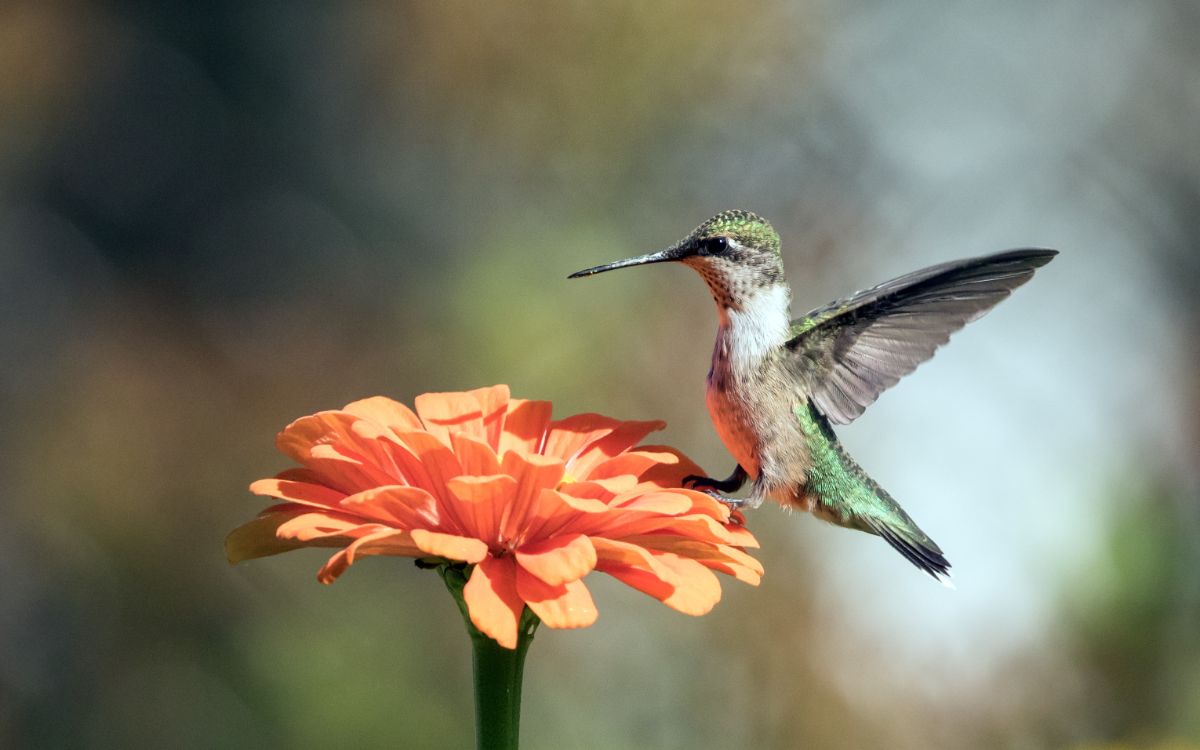
Hummingbirds feed on nectar from flowers, so one of the best ways to attract these pollinators to your garden is to plant nectar-rich blooms. Be sure to include a wide variety of plants that bloom at different times of the growing season to guarantee that whenever hummingbirds arrive in your space, they’ll always find something sweet to eat.
We hope this article has inspired you to start planting a hummingbird garden this year. For more pollinator gardening tips, read up on our guide right here.

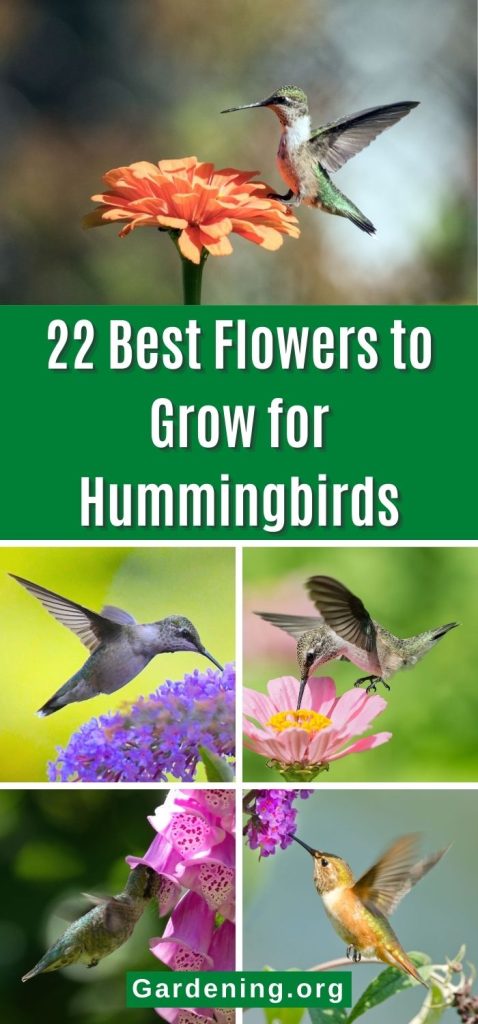
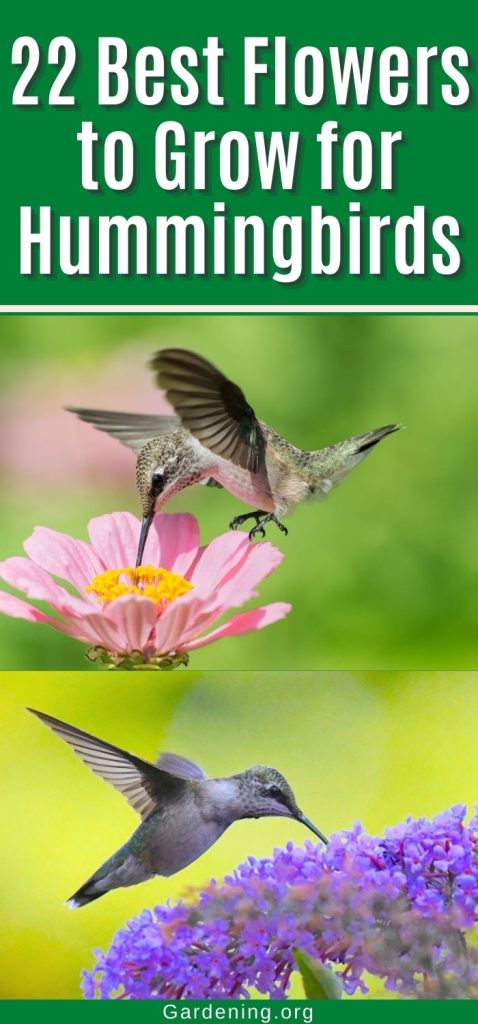
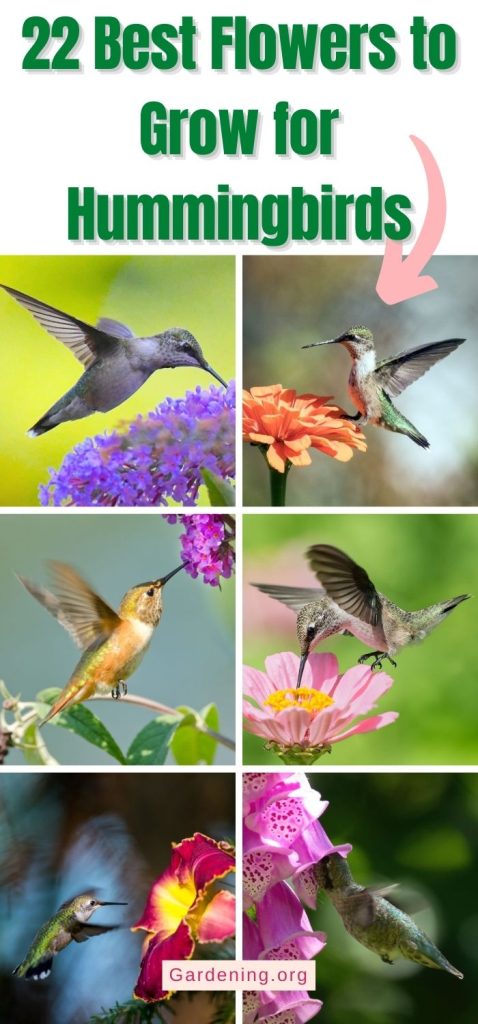


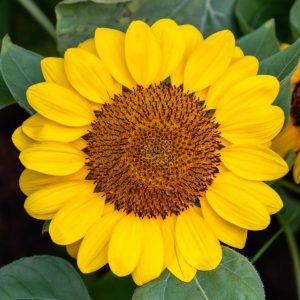
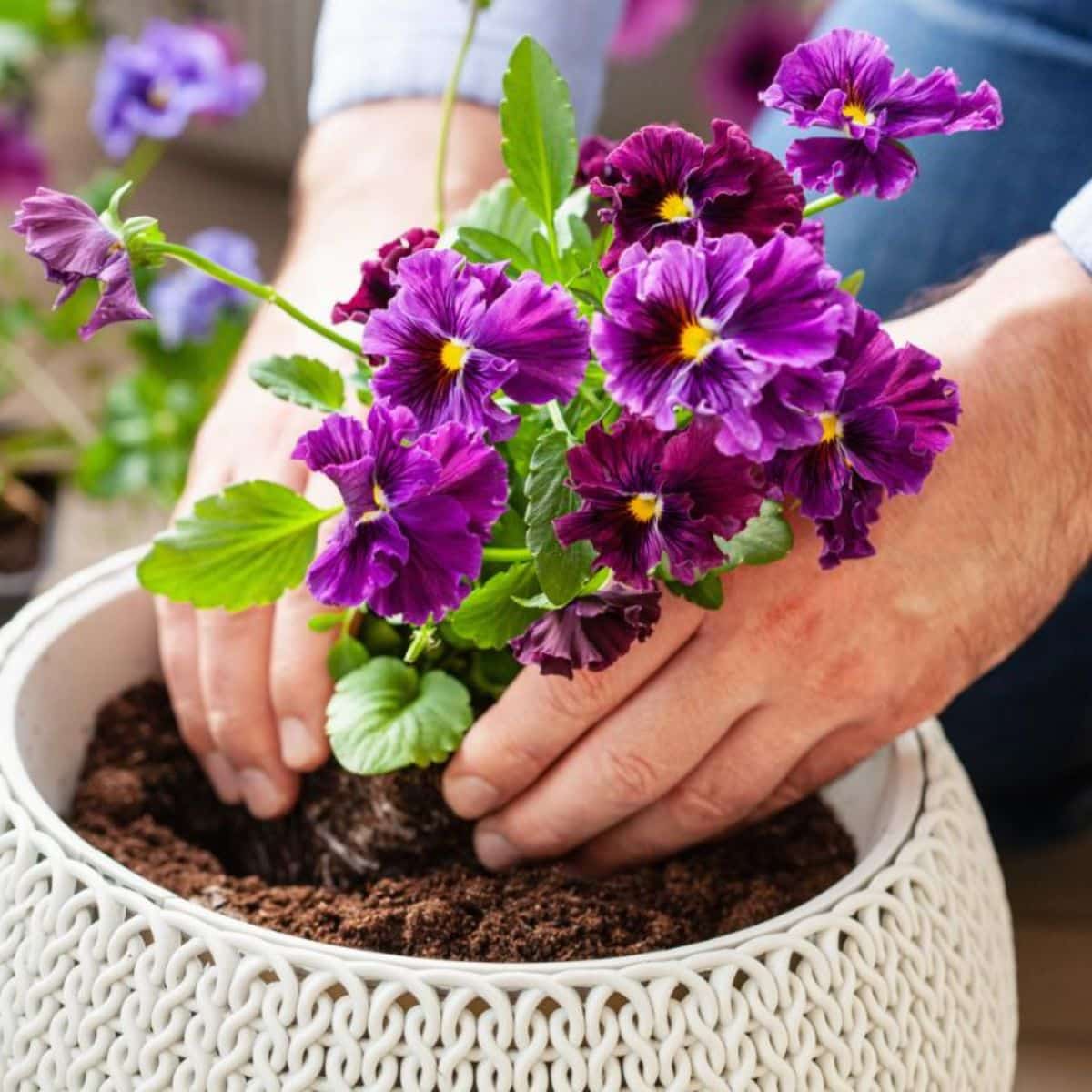
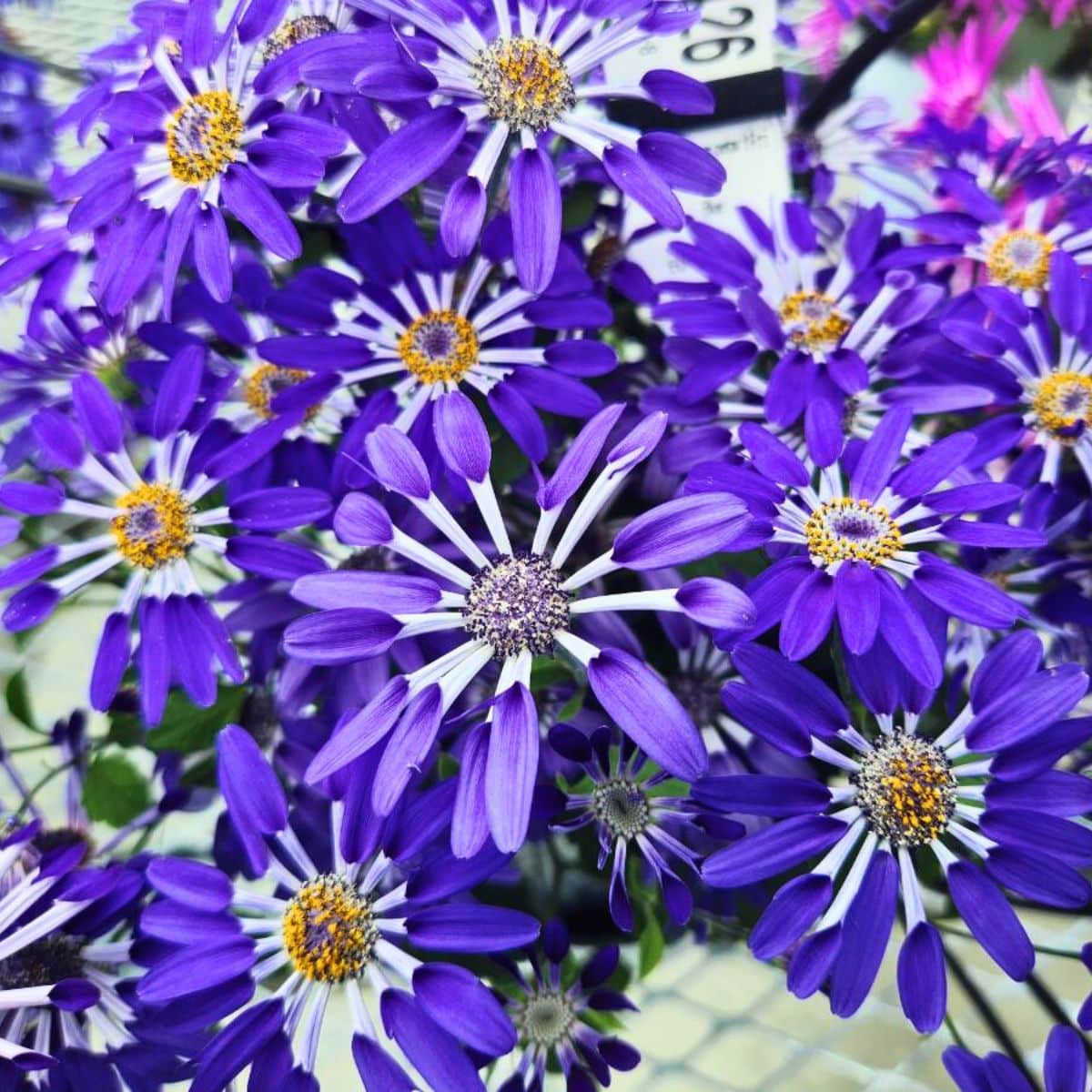
Melody Fleck
Thank you for helping me find plants for my hummers!!
Rick
Thank you for the add and the best 22 plants that attract hummingbirds.